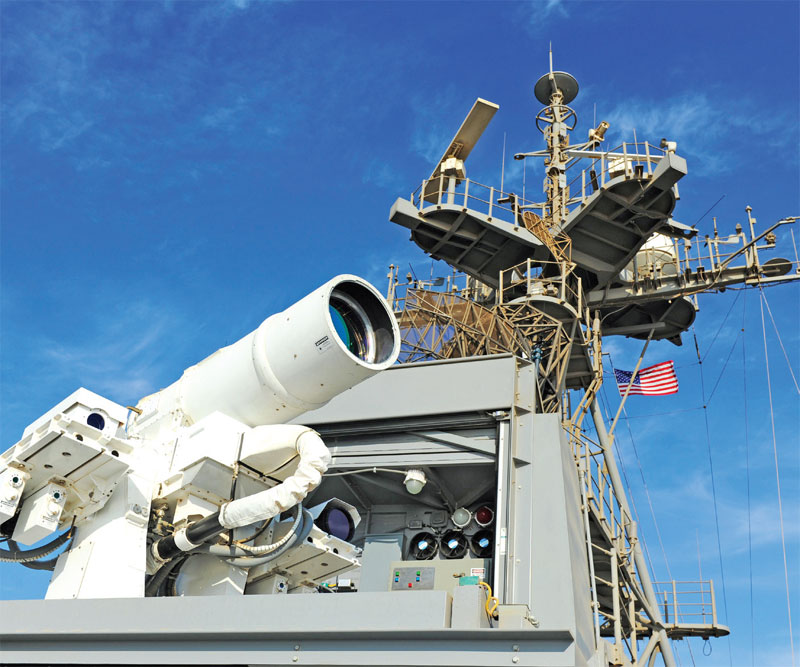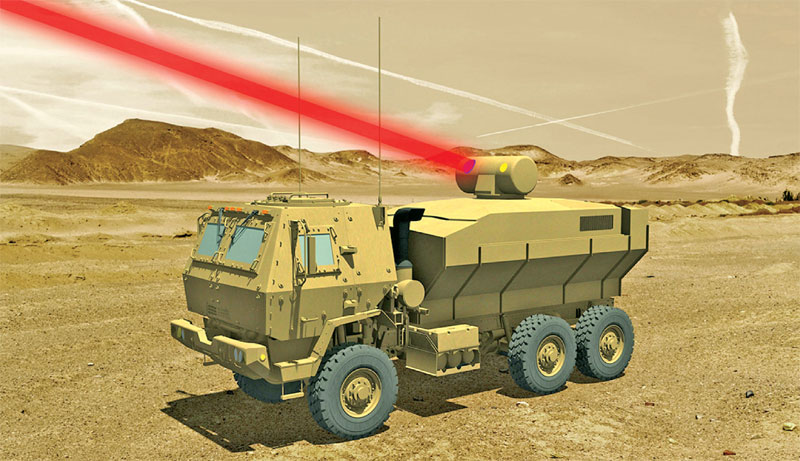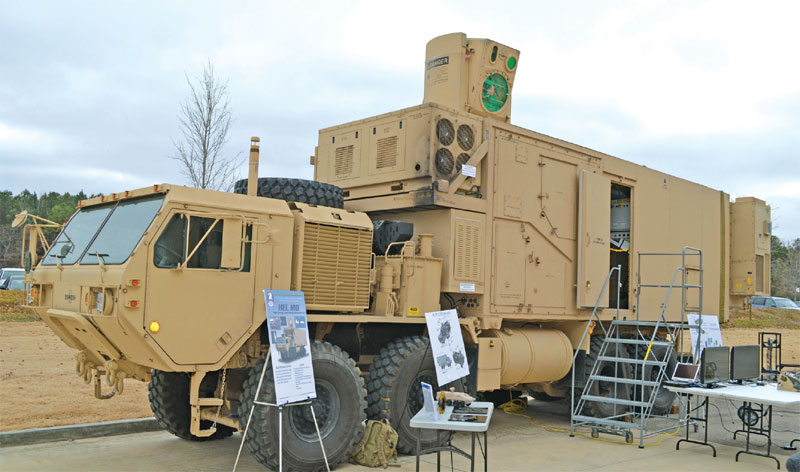How lasers can take out the hypersonic cruise missiles
Prasun K. Sengupta
Hypersonic missiles travel at a speed of one mile per second or more—at least five times the speed of sound. They are able to evade and conceal their precise targets from air-defence networks until just seconds before impact. This leaves targeted countries with almost no time to respond. Additionally, such weapons are capable of destroying targets without any explosives, using their sheer kinetic energy alone. Hypersonic missiles also require a reconsideration of traditional second-strike calculations, as they have the potential to decapitate a nation’s leadership before it has the opportunity to launch a counterattack.

Consequently, a country facing a hypersonic missile threat must make the best of a bad situation, in other words being effectively forced to choose the lesser evil. It could authorise the military rather than the national leadership to conduct retaliatory strikes, but this would raise the risk of an accidental conflict. It could spread out its forces, making them more difficult to attack, but also rendering them more susceptible to sub-national seizure through a greater number of access points. It could deploy its regionally-strategic forces upon receiving the first warning of an attack, which would make crises exceedingly unstable. Finally, it could launch a pre-emptive strike upon its enemy. All of these choices invite trigger-happy state behaviour.
Given that the proliferation of current generations of ballistic missiles poses many of the same problems as the spread of hypersonic missiles, do the latter really present a unique challenge? For countries without ballistic missile defences (BMD), hypersonic missiles add relatively little in the way of a threat. However, an increasing number of countries are procuring missile defence systems, particularly against regionally-ranged threats. These systems could be effectively neutralised by hypersonic missile technologies.
The United States, Russia, and China are leading the race to develop hypersonic missiles, with Japan, France and India close behind. Japan, Australia, and Europe are all developing the component technologies, in some cases for ostensibly civilian purposes. Within six years, hypersonic missiles are likely to be deployed and potentially offered on the international market.
Is there no way to avoid a world with widespread hypersonic forces? Hypersonic technology itself offers hope, as it is extremely difficult to master. Igniting the engine of a hypersonic cruise missile has been compared to lighting a match in a 2,000 mile per hour wind. Moreover, the shape of the missile changes under the rigours of hypersonic flight, creating great challenges for flight control.
Hypersonic defence is a difficult but, ultimately, tractable problem. Relative to the legacy BMD systems, these new threats will require considerable change, to be sure, to include different defence architectures, new sensors in interceptors and doctrinal organisational changes as well as modified policy expectations for the defended assets list, much of which is already underway. The high supersonic, or hypersonic flight regime, beginning around Mach 5 corresponds to a set of aerodynamic and thermal phenomena that a vehicle undergoes in that regime.
Hypersonics is an attribute, not a particular thing, for several reasons. For one, the relationship to the speed of sound underscores that this is an atmospheric phenomenon, and a focus on the characteristics or the attributes of hypersonic flight is also to emphasize that the hypersonic threat spectrum is not confined to boost-glide vehicles, to scramjet type cruise missiles, or multiple autonomous re-entry vehicles (MaRV). There may yet be other possible delivery systems and types—spaceplanes, and hypersonic trucks among them—that partake of high-speed manoeuvring characteristics and sustained hypersonic flight.
In other words, the threat is only going to get more diverse and so one needs to focus on the characteristics, and not on just one or two types of weapons platforms. The penchant to call everything a hypersonic makes things a little bit more convoluted and in some ways, underestimates the scope of the challenge. Nevertheless, the attributes of hypersonic missiles represent a broader trend in advanced missilery away from purely ballistic trajectories and toward lower, more manoeuvrable, and more—and less predictable flight. It is not just about the speed. The more circuitous routes may, in fact, take longer than a simple ballistic flight. But how we approach hypersonic missile defence and the characteristics of hypersonic missile threats will shape the broader missile defence enterprise.
Conversely, giving up on hypersonic defence could, ultimately, result in capitulation for the active missile defence mission. Finally, focussing on the characteristics of atmospheric hypersonic flight points to how we might reformulate the active defence mission. As with other air defence threats, it is going to require a more limited defended assets list. But also, as it turns out, every feature that makes hypersonic missiles attractive also comes with a cost. They bring a different set of vulnerabilities for a defender to exploit, and the vocabulary of air-defence is different than that of BMD. It may be possible to impose costs upon and shape the character of the threat.
Hypersonic weapons and ballistic missiles do both travel at hypersonic speeds, but ballistic missiles are travelling along a predictable parabolic trajectory, whereas hypersonic weapons are able to manoeuvre throughout their course of flight. It can make it challenging to determine what their intended target is. Hypersonic weapons also fly at a lower altitude than ballistic missiles and that means that they can under-fly the line-of-sight detection capabilities of ground-based radars. It is also challenging to detect them using existing space-based sensor architectures. Hypersonic weapons are 10 to 20 times dimmer than most weapons that one would generally track with existing early-warning architectures. And so it is really, again, that combination of speed, manoeuvrability, and flight altitude that is increasing the challenges of defending against them.

The requirements for achieving lift and minimising drag and heating force: Hypersonic systems operate in what is typically called the near-space regime, which is between 20km and 100km. By the way, China appears to be approaching hypersonics as a domain, like land and sea, so that it can exploit and see the significance of this altitude regime by often using the terms near-space and hypersonics interchangeably. There are a number of papers by an institute called the Beijing Institute for Near-Space Vehicles on hypersonic glide vehicles. Near-space can also be very, very slow, but it is a domain that China wants to dominate the same as land and sea.
What altitude gets you and why it is important, is that it gets you lift over drag, which gets you manoeuvrability. Altitude gets you control authority, and then it also gets you heating. So it results in different technologies in terms of what one needs for BMD. So, typically, divert attitude control systems are critical for BMD, but then for cruise missile defence one is using aerodynamic forces and control surfaces. So hypersonics forces us in that sweet spot of where traditional air and missile defences lie. So one needs to have a mix of technologies and a new approach to hypersonic missile defence. Then there is the curvature of the Earth that limits the engagement parameters of ground-based early-warning sensors.
This, of course, also poses a big challenge for command-and-control, and this is what makes space-based sensors the single most important programme element for the hypersonic defence architecture. Of course, the sensor challenge for hypersonic threats is different than that of ballistics. Looking down upon clutter, there is an infra-red (IR) signature that can be brought up, but it is a different challenge. And that is why one has to get a different kind of sensor architecture. But it also translates to the interceptor side of the house, and today’s interceptors may not be sufficiently agile and have a sufficient divert to cover the full possible place where manoeuvring vehicles of one kind or another may be, and that is why one sees movement on a glide phase interceptor that has greater divert capability—it flies out further. Whether that is hit to kill or whether that is blast-frag and its effector remains to be determined. Hypersonic weapons are fast but they do not quite turn on a dime, and if high-speed manoeuvrability is a key feature and attribute, it is also a potential weakness. The heat and drag imposes limits on their ability to manoeuvre and they expend energy in doing so, and this suggests that there may be things that can be done to either encourage manoeuvre and even in the absence of a space-based sensor layer, forward-based sensors even at the surface can do a lot of good.

Possible Hypersonic Defence Solutions
Technologies such as high-power (up to 300 Kilowatt) solid-state directed-energy weapons (DEW), particle beams and other non-kinetic weapons are likely candidates for an effective defence against hypersonic missiles. Another countermeasure is a network of space-based satellites equipped with sensors that will be able to track hypersonic glide vehicles globally.
This would be a huge first step in hypersonic missile defence. Once engineers find a clean, practical and efficient way to produce all the required electric power, they will also need to focus it into an ultra-precise beam. That, in turn, takes bigger optical mirrors with coatings that can withstand such a massive amount of energy. And, of course, they will need a vehicle that can carry it all. Examples of such efforts now underway include Lockheed Martin’s shipborne 60-kiloWatt (kW) High-Energy Laser with Integrated Optical dazzler and Surveillance (HELIOS) system, Boeing’s 50kW High Energy Laser Mobile Demonstrator (HELMD), Raytheon Intelligence & Space’s 50kW High-Energy Laser Weapon System (HELWS), and RAFAEL Advanced Defence Systems’ Iron Beam 100kW DEW.
Much of the effort in recent years has focused on high-power fibre-lasers that use specially doped coils of optical fibres to amplify a laser beam, and were originally developed for industrial cutting and welding. Initially, fibre-lasers were dark horses in the effort to develop electrically-powered solid-state DEWs that began more than two decades ago. However, by 2013, the US began testing a 30kW fibre-laser on a warship. Since then, their ability to deliver high-energy beams of excellent optical quality has earned fibre-lasers the leading role in the on-going trials of DEWs in the 50kW/ 100kW categories.
Boeing has teamed with General Atomics to challenge fibre-lasers in achieving the 300kW threshold that will be essential for future generations of laser weapons to counter hypersonic weapons. The challenging technologies have since been developed to control crucial issues with high-energy solid-state lasers: size, weight and power, and the problem of dissipating waste heat that could disrupt laser operation and beam quality. General Atomics has come up with a completely new solution: liquid laser, which was considered completely crazy at one time. Liquid lasers are similar to solid-state lasers, but they use a cooling liquid that flows through channels integrated into the solid-state laser material. A crucial trick was ensuring that the cooling liquid has a refractive index exactly the same as that of the solid laser material. A perfect match of the liquid and solid could avoid any refraction or reflection at the boundary between them. Avoiding reflection or refraction in the cooling liquid also required making the fluid flow smoothly through the channels to prevent turbulence.
China’s DEW-related developmental efforts are spearheaded by the China Academy of Engineering Physics CAEP), AVIC Manufacturing Technology Institute, and the Military Resident Representative Bureau of Special Equipment of the People’s Liberation Army Rocket Force. China has pursued the development of two military BMD-related lasers: Free Electron Lasers (FEL) and Chemical Oxygen-Iodine Lasers (COIL). FEL research started at CAEP in 1985, resulting in the activation of the SG-1 laser in 1993.

The Dalian Institute of Chemistry & Physics began R&D on COIL in the 1980s and an early model was tested out to a range of 140km in 1993. The Changchun Institute of Optics, Fine Mechanics and Physics, one of China’s leading centres for the development of civil and military applications laser technology, in 2005, successfully conducted a satellite blinding experiment using a 100kW capacity mounted laser gun in Xinjiang province. The target was a low-orbit satellite with a tilt distance of 600km. The diameter of the telescope firing the laser beam was 0.6 metres wide. The accuracy of acquisition, tracking and pointing (ATP) was less than 0.5 microradians. According to this Institute, by 2023, it should be possible for China to build a space-based laser battle platform weighing 5 tonnes and carrying 2.5 tonnes of chemical laser fuel. This platform will be able to fire a 1 megawatt laser for up to 100 seconds out to a range of 5,000km and possess an accuracy of 0.5 microradians. Officially, such a system, to be fully deployed by 2026, will be known as a near-Earth asteroid defence system to deal with the threat of near-Earth asteroid impacts
Russia has been developing BMD-related airborne lasers since the early 1980s and its R&D project for intercepting hypersonic weapons was initiated in 2003 under the name of ‘Sokol-Eshelon’. On 28 August 2009, a Beriev A-60 airborne testbed equipped with the the 1LK222 laser system fired a laser beam at a Japanese geodetic satellite called Ajisaj, which was at an orbital height of 1,500km. The test was not designed to damage the satellite, but rather took advantage of the presence of corner reflectors on the satellite to test the targeting system against a satellite in a known orbital path. Russia has also been working on a stationary ground-based capability to dazzle or blind hypersonic glide vehicles and satellite sensors using an optical/ laser space surveillance facility in the North Caucasus.
The facility is part of the Krona complex, situated on the Chapal Mountain near Storozhevaya. Krona comprises a radar installation to identify satellites and categorize them by type and a so-called ‘laser optical locator’ (LOL), comprising a 0.4-metre wide-angle telescope for the detection of satellites in high orbits, a 1.3-metre narrow-angle telescope with adaptive optics for high-resolution imaging of satellites in low orbits, and a LIDAR (also called the ‘transmit-receive channel’) used to accurately measure distances to satellites. Early last decade work got underway on upgrading the laser complex under a project code-named Kalina (‘guelder rose’), led by the Scientific & Industrial Corp ‘Precision Instrument Systems’ (NPK SPP). The company signed a contract for Kalina (also called 30Zh6MK or 30Ж6МК in Cyrillic) with Russia’s ministry of defence on 3 November 2011.

